Moogfest 2011 Wrap-Up
For the second year in a row, the city of Asheville, North Carolina celebrated the […]
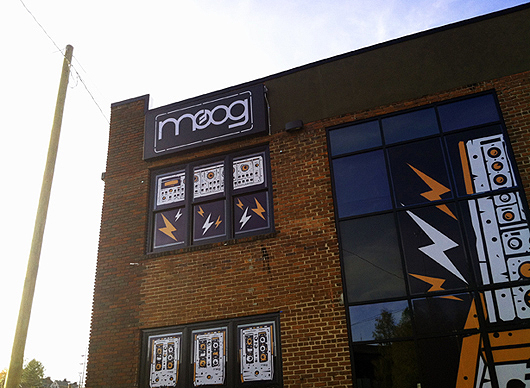
Moogfest 2011 Wrap-Up
For the second year in a row, the city of Asheville, North Carolina celebrated the […]

For the second year in a row, the city of Asheville, North Carolina celebrated the legacy of former resident and innovator of the synthesizer Robert Moog with a festival featuring the eclectic, electric sounds that he was integral in making possible. This year’s Moogfest fell once again on Halloween weekend, which lent the festivities a bit of a rave-ish vibe. Colored wigs, reflective jumpsuits, and various accessories of the glowing variety were a common sight when glancing across the throngs of festival-goers spread throughout the small college town that is still home to the Moog factory (pictured above). I had to wonder if Mr. Moog would be entirely pleased with being honored in this way, as the festival largely feels like a suburban Burning Man. Regardless, all performing artists in attendance were there to pay tribute to the visionary with some of the best music that can be seen and heard today, and did so in spades.
Day One
Beak>
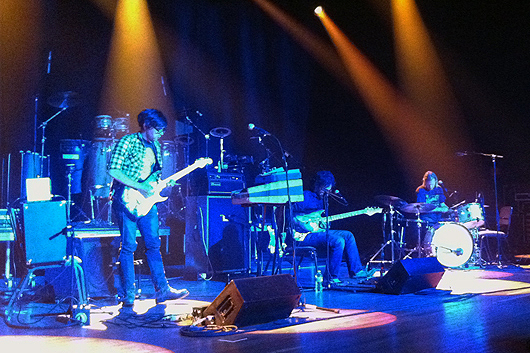
Moogfest started early Friday evening in the midst of a chilly drizzle that made trekking from venue to venue feel a bit more laborious than the 10- or 15-minute walks might otherwise be. Geoff Barrow’s Kraut-indebted side-project, Beak>, was the first act I caught, and proved to be a fitting start to my weekend, as the jammy song structures and pulsing rhythms made for a smooth sonic brew to ease into. Atlas Sound was setting up across the way over at the Orange Peel, so I dipped out of Beak>’s ambling performance a little early in order to make the start of his set.
Deerhunter frontman Bradford Cox was on stage alone, surrounded by his guitar, effects pedals, a drum machine of some sort, and a Moog synthesizer. It was the most gear I’ve ever seen him use in a solo performance, and it seemed that maybe the setup was new to him, too. Instead of playing some of his experimental bedroom-pop tunes, Cox spent more time self-indulgently jamming on his gear (quite loudly, might I add), which yielded both interesting and tiring results. Some people were plugging their ears by the time I left to grab a bite to eat.
Atlas Sound
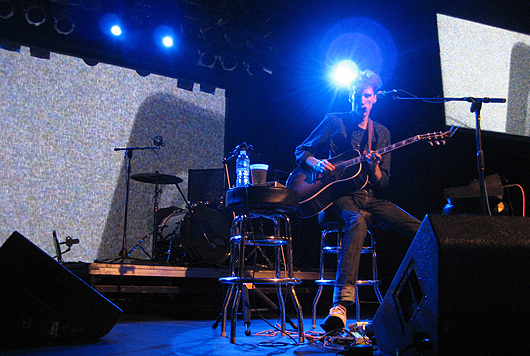
Tangerine Dream
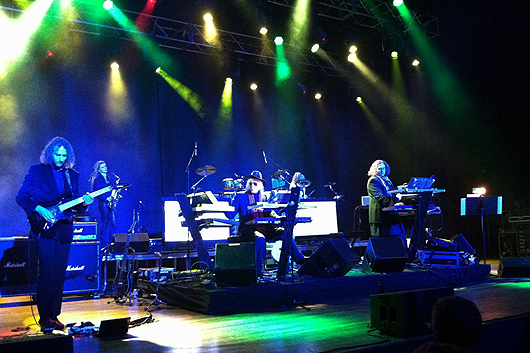
After stopping in one of Asheville’s many fine restaurants, I headed to the Thomas Wolfe Auditorium to catch the unlikely performance of German new age/prog pioneers Tangerine Dream. The six-piece outfit was in the middle of fleshing out pieces of its unbelievably large repertoire when I arrived. I didn’t recognize any of the songs Tangerine Dream performed, but was mesmerized by both the massive amount of gear the band had on stage and the immense sound they produced through the auditorium’s soundsystem. Up in the front, the subs quite literally moved me, and even the cheeseball guitar and sax solos sounded pristine enough to be chocked up to nostalgia rather than kitsch.
After Tangerine Dream took a bow and 69-year-old band leader Edgar Froese addressed the adoring crowd concerning his love for Bob Moog, The Field set up with a drum kit on stage right, a bass and synth rig on stage left, and mastermind Axel Wilner placed front-and-center, armed with a couple of samplers and a mixer. The trio kicked things off with Looping State of Mind opener “Is This Power,” and, despite a poor mixing job from the house, compelled the excited audience to groove along with lengthy renditions of pulsing jams taken from all three of its LPs.
The Field
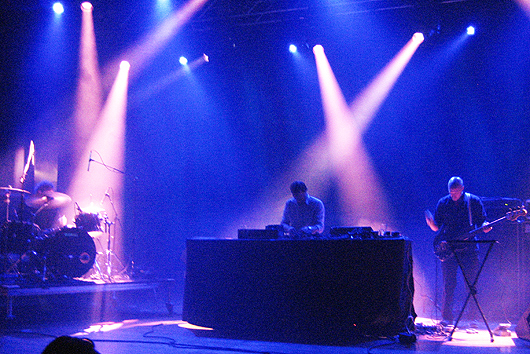
The final event of my first night at Moogfest was a surreal performance by elusive dubstep badboy Zomby at the Orange Peel. I use the word surreal mostly because of the crowd in attendance, not the performer himself. When I arrived roughly in the middle of the third track Zomby had selected to play off his laptop, the room was at about half capacity, which felt slightly odd considering that the masked producer would likely sell out a night in any other city. But things continued to grow more strange; while Zomby dropped dirty grime and rap tunes from the likes of Soulja Boy, Dizzee Rascal, and The-Dream, along with a cut or two of his own (like the excellent “Tears in the Rain” from Where Were U in ’92), the audience waned, seemingly miffed by his anti-climactic “performance” and his utter lack of stage presence. There were about 30 people left in the room when Zomby ended his set. It solidified my notion that maybe most of the people in attendance at Moogfest this year aren’t as interested in an artist’s hype and self-imposed mythos as they are in seeing exciting live music from talented performers. And really, who could blame them?
Zomby
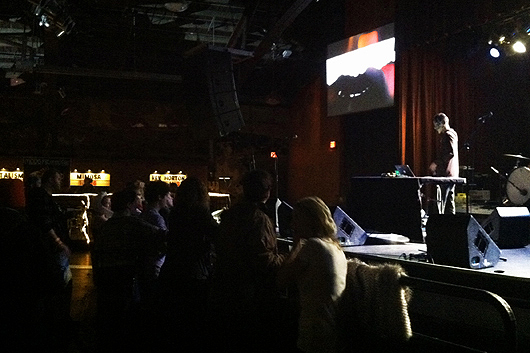
Day Two
Brighter skies greeted me on Saturday, and assuaged all fears that I’d be spending much of my stay in Asheville bogged down by weather I hadn’t packed for. By the time SBTRKT went on early that night at the Asheville Civic Center Arena, not much had changed aside from the dropping temperature, but that didn’t stop the attendees from donning their Halloween costumes and party garb. The South London duo of SBTRKT and singer Sampha played through high-energy versions of “Something Goes Right,” “Heatwave,” and other selections from the producer’s self-titled LP with a live drum set, vocal effects, and a handful of synths and MIDI controllers. The crowd ate up the pop-minded dance tunes like they were at the peak hours of an all-night rave, which left me wondering how Tim Hecker would fare when he took the same stage hours later.
SBTRKT
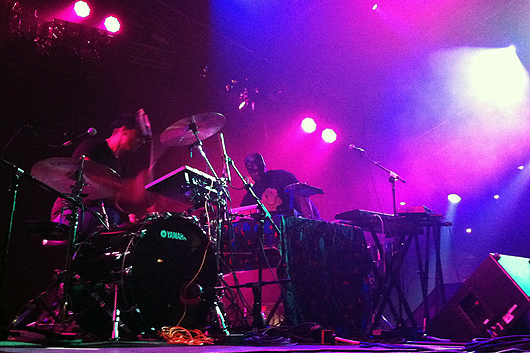
Terry & Gyan Riley
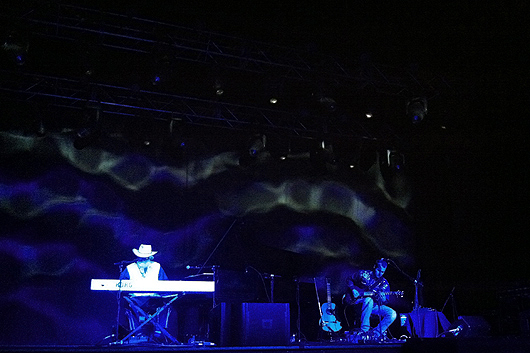
Before Tim Hecker appeared on the arena stage, I had the privilege of watching experimental composer Terry Riley perform in the Thomas Wolfe Auditorium next door. The artist played his minimalist pieces along with his son, guitarist Gyan Riley, alternating between a grand piano and an electric keyboard throughout their set. Riley said very little to the seated audience between songs, but made one remark about the pair rehearsing on the way to Asheville, to which Gyan added, “We were on different flights.” After the laughter subsided, the duo launched into a serenely spellbinding piece of music that found both Terry and son jumping between a bevy of different sounds on their respective instruments—maintaining the understated, hypnotic vibe throughout. You could see most of the crowd with their eyes closed, soaking up the transportive sounds.
Tim Hecker
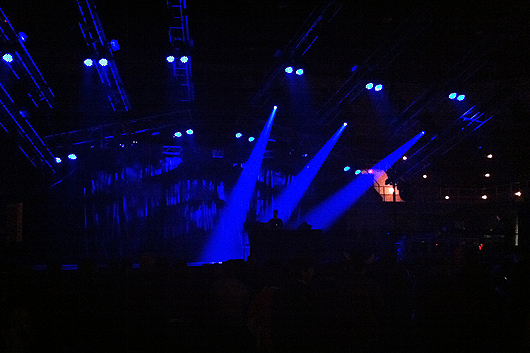
In what was easily the strangest billing of Moogfest, Canadian noisenik Tim Hecker performed sonically crushing pieces from this year’s gorgeous Ravedeath, 1972 LP at the festival’s largest indoor venue. Hecker unleashed his assault of chopped and treated sound on the same stage that featured the likes of Moby, TV on the Radio, and Ghostland Observatory throughout the weekend. The arena was at roughly 10% capacity during most of Hecker’s set. While the lush washes of static and punishing bass of “The Piano Drop” rattled my insides, I watched as two kids played Connect Four and a couple of underage girls (who were almost certainly rolling) ran around in some kind of game of tag. I couldn’t help but think that maybe the tastes of the Moogfest promoters are somewhat loftier than their audience. Still, toward the back of the small crowd, a number of people were seated on the ground, basking in the vibrations of Hecker’s engrossing music. The performance was over 20 minutes earlier than it had been billed.
Suicide
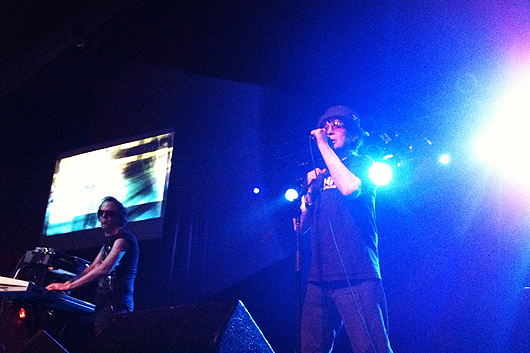
A short walk took me over to the Orange Peel, where Suicide was scheduled to perform its seminal self-titled LP in its entirety. Thankfully, the landmark event was not lost on Asheville and its festival-goers, as the room was absolutely packed and brimming with excitement. 73-year-old Alan Vega and Martin Rev sauntered on stage and immediately jumped into “Ghost Rider.” The tune’s instantly recognizable bassline was met with screams of enthusiasm from the crowd, and Vega fed off the energy like a veteran performer. While Rev blasted out the powerful drum-machine rhythms and gritty synth riffs of Suicide (including highlights like quasi-ballad “Cheree” and epic ode to the everyman “Frankie Teardrop”), the vocalist wailed and postured on stage—smoking a cigarette, grabbing his crotch, and yelling into the audience like it was 1970s CBGB. It was something of a sight to behold, and one of the best performances I saw during Moogfest.
Kode9
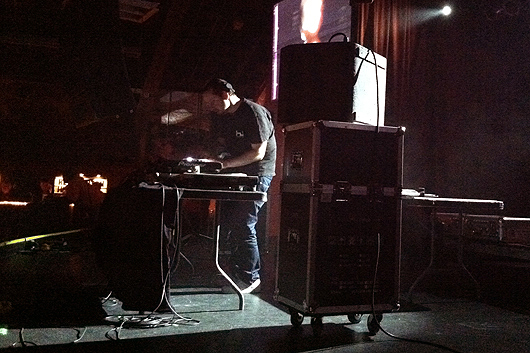
After a lengthy change over and far more Red Hot Chili Peppers and 311 than one should ever be forced to listen to, Hyperdub head honcho Kode9 delivered a tremendous DJ set to an insatiable dancefloor. The mixmaster kicked things off with heavyweight tunes like Mosca’s “Done Me Wrong” and “Hover Traps” by fellow Glaswegian Rustie, which paved the way for choice bits of high-octane grime, heavy-handed dubstep, and other tasteful bass-centric genres. There wasn’t a static body within the ebullient crowd, and as I gradually made my way through the mass and out the door, I only saw more and more people filtering into the Orange Peel. Kode9’s set was certainly the dance party of the night.
Day Three
M83
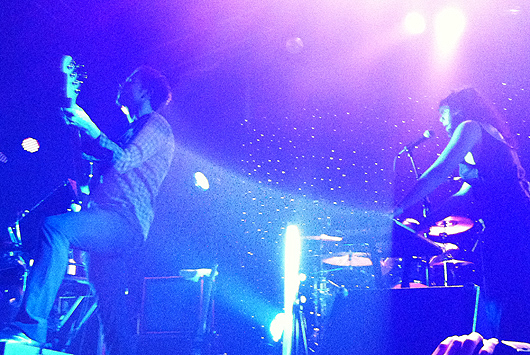
M83‘s was the last performance I saw during Moogfest, and even though the final day of the festival also featured sets from the likes of Neon Indian, John Maus, Oneohtrix Point Never, and Gold Panda, Anthony Gonzalez’s immense stage show was enough to satisfy even the hungriest of live music appetites. Like its impeccable new LP, Hurry Up, We’re Dreaming, M83 presented a cinematic spectacle inside of the Asheville Civic Center Arena, starting with a walk-on of the boy in the alien costume from the new album’s artwork. He slowly raised his arms as the synth arpeggiations and sub-bass of opening track “Intro” swelled from the soundsystem and Gonzalez & Co. took their positions. During this small bit of theatrics, it became readily apparent that something special was going to happen.
M83’s alien boy on screen
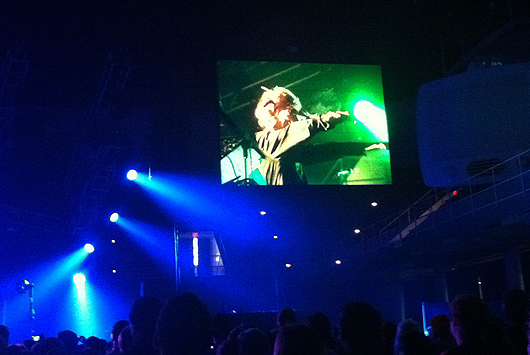
The band followed up its first tune with lively versions of “Midnight City” and “Reunion” before jumping into older material like “Kim & Jessie” and “Teen Angst.” As Gonzalez was joined by a live drummer, a young multi-instrumentalist (whose 20th birthday happened to be that night), and a female vocalist/keyboardist, M83 sounded fuller than I’d ever experienced from them in a live setting. The brilliant music, flashy on-stage lighting, and passionate performances from the artists created a commanding presence in the arena, more so than any band I’d seen in the past few days. During an excellent rendition of Hurry Up standout “Steve McQueen,” it occurred to me that maybe this is what Gonzalez had been striving for all along. His band had achieved what looked and sounded like stadium-sized stardom, and it suited them very well.
M83
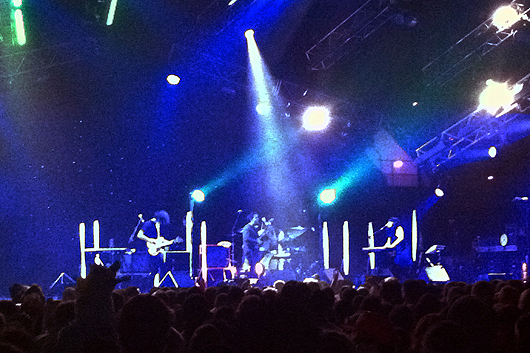
Before the show had begun, a screen suspended near the stage displayed text messages sent from the audience to a special number. One of those messages that popped on screen read, “I came to Moogfest just to see M83.” I got the sense that maybe everyone in the near-capacity audience felt that way, too. I can certainly say that there were moments during Gonzalez & Co.’s hour-plus performance where I felt just the same, and when I left the venue on a high of seeing such a powerful live band (not to mention a personal favorite), it seemed that all of the weekend-long festival had been leading up to that point. It was the perfect note to end my stay at Moogfest on, so I went back to my hotel and prepared to return home.

